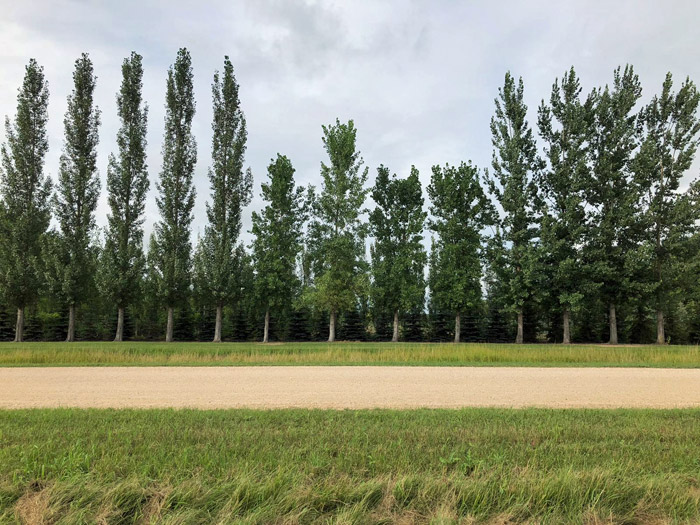In Manitoba the land is very… Flat! This can make for a couple problems including lack of privacy and incredible wind gusts. I have talked about it before how shelterbelts and hedges can be a very helpful factor in amending this. Of all the different trees used for shelterbelts none are more popular than the Poplar, and there are several reasons for this.
One of the first poplars to really gain popularity in our area was the tower poplar. A beautiful upright crossbreed between the Swedish Aspen and Silver Poplar. They were seedless, had a fantastic growth rate, very space efficient and had compact foliage for blocking the view. It had a few flaws though. As it was from the Aspen family it often had sucker shoots growing up out of the ground from the roots. This could quickly make one tree into thirty if you did not stay on top of them. As time went on the Bronze Leaf Disease became an issue as well. Foliage begins turning brown in mid-summer and the tree would start to shed leaves. Branches and eventually entire portions of the tree would begin dying off. There has been no cure for bronze leaf disease and other options were needed. This is when the Prairie Sky Poplar really started to gain popularity.
Prairie Sky Poplar was another hybrid poplar meaning it was also seedless. Being part Cottonwood, it had an incredible growth rate immature size of 60 to 80 feet high! And yet it only grew to be 15 feet wide. Without have any aspirin genetics I did not put out any sucker shoots from the roots and quickly gained more popularity than the tower poplar. It has been the top of the market poplar for many years now. But a challenger has come into the scene.
The Sundancer poplar, previously named Escott poplar, is another hybrid poplar with even more merit in the prairie sky. With a mature height of 40-50 feet and width 10 feet it is more space efficient than the towering Prairie sky Poplar. It is also seedless and does not sucker from the roots with a growth rate that is also comparable. The biggest difference that has been seen is in cold hardiness. The Prairie sky Poplar has always done well for us in Manitoba accept when we have had exceptionally wet falls. This sometimes results in the Prescott poplar is not shutting down properly and growing longer into the season. This can result in freezing back of the fresh growth and sometimes overall death of the tree. The Sundancer poplar does not seem to have this issue making it just that much more reliable.
Well, the Sundancer poplar and many other poppers are very space efficient trees above ground, Beneath the ground is a different story. Most trees will have a route spread that is comparable to the canopy of the branches. Poplars are an exception to this rule. While the tree itself is tall and narrow the root system tends to be shallow and widespread. Poplars will often have 3 to 4 major roots that spread out in different directions giving stability and drawing and nutrients. Some mature Poplars have been said to have roots up to 100 feet long in any given direction. This makes it essential that poplar is planted at least 50 feet away from driveways or buildings or anything else at the roots could potentially damage.




